DCPA NEWS CENTER
Enjoy the best stories and perspectives from the theatre world today.
Enjoy the best stories and perspectives from the theatre world today.
Have you ever fantasized about going back in time, just like Marty McFly does in Back to the Future? Were things simpler back in the day or pretty similar?
Imagine if you could get in a time machine to see Denver in 1955 and 1985 — what might you see in the Mile High City?
Let’s take a trip back to these years (maybe with Marty McFly in tow) to picture the Queen City of the Plains and find out where it’s possible to walk in history even today. Many of the city’s iconic places — the state capitol building, Larimer Square, Union Station, the Brown Palace Hotel, and even Red Rocks Park and Amphitheater to the west — were all standing by 1955.
Denver in 1955
Denver was experiencing a boom cycle in 1955 with a population of 415,500 in 1950, a 29% increase from 10 years earlier. The city was just over 100 years old as the founding was marked in 1858 with the discovery of gold nearby.
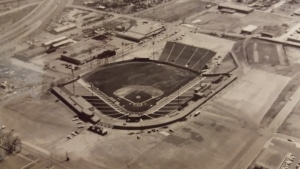
Bears Stadium. Photo courtesy Denver Public Library Special Collections
Like many cities across the country, this was a time of awakening civil rights and the city’s first Black city council member, Elvin Caldwell, was elected.
Maybe you can see the Denver Bears play a game of baseball at the original Mile High Stadium, called Bears Stadium. This stadium, today known for hosting football games and concerts, was built in 1948 for baseball. The team, which changed their name to Denver Zephyrs in 1984, was still playing in this stadium until 1992. The National Ballpark Museum in LoDo has some of the original seats and team jerseys on display today.
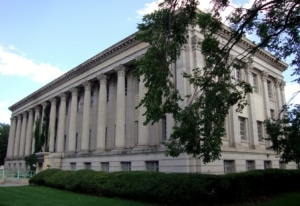
Denver Public Library’s “Old Main” Building, now the McNichols Building
You will see the Denver Public Library’s Central branch under construction in 1955 as it opened in 1956. Designed by Burnham Hoyt with the firm Fisher and Fisher, the new construction was double the size of the existing Carnegie Library which still stands today in Civic Center Park, now called the McNichols Civic Center Building.
World-renowned architect I.M. Pei was making his mark on Denver in the 1950s, so a visit in 1955 would include seeing the construction of his Mile High Center at 17th and Broadway. Today just a minimalist office building remains as the distinctive plaza and pavilion were torn down in the 1980s.
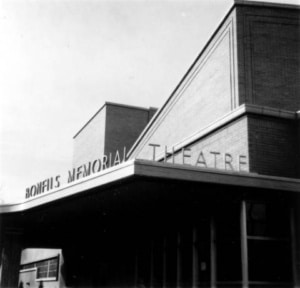
Bonfils Memorial Theatre
The Valley Highway, just referred to as I-25 these days, running north to south through Denver was still under construction so you might see some dirt roads. If you want to venture to Pueblo on this route, it would take at least eight hours – today you can zip down to Pueblo in under two hours!
To see a live performance such as theatre or opera, you can visit the new Bonfils Memorial Theatre that opened in 1953. This later became known as the Lowenstein Theatre and is still standing today in the Capitol Hill neighborhood as the Tattered Cover Bookstore.
Welton Street in Denver’s Five Points neighborhood was the place to go for hearing live music by greats like Billie Holliday and Duke Ellington. With over 50 bars and nightclubs, this was known as the Harlem of the West during this period.
Denver in 1985
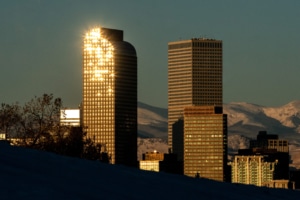
Cash Register Building. Photo by Hart Van Benburg for Colorado Public Radio
Denver experienced a bust cycle in the early 1980s – the population actually decreased to 504,439 (it was 505,507 in 1984 and 511,007 in 1983) and didn’t really rebound until about 1995.
After decades of growth, the city fell on hard times in the 1980s after the oil bust and the local economy became stagnant. Although this wasn’t a time of renewal, there were several newly constructed (and “renovated”) buildings downtown. You will see the freshly-completed Republic Plaza, at 56 stories, the tallest building in Denver. Perhaps the most recognizable building of the Denver skyline is the Cash Register building, initially called the One United Bank Center, it was completed in 1983.
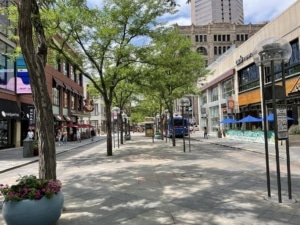
The 16th Street Mall
Federico Peña has been mayor for two years and will continue to hold this role until 1991, just a few years before his pet project of moving Stapleton Airport farther east to become Denver International Airport is completed.
By now, the Denver Broncos are playing at Mile High Stadium so you might catch a football game. The current stadium, Empower Field, was built in 2001.
The 16th Street Mall (designed by the aforementioned architectural firm I.M. Pei & Partners) opened in 1982 so you can stroll through this downtown area to shop, have lunch, or visit someone at their office.
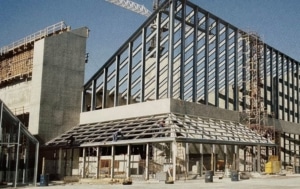
Construction of the Helen Bonfils Theatre Complex
Just a few blocks away, you might be able to see an Opera Colorado performance at Boettcher Concert Hall; Opera Colorado was still new, having formed in 1983 when they staged their first show in Denver. Yes, the Denver Center for the Performing Arts’ Helen Bonfils Theatre Complex was built in 1979 so you can stop and see a show at this time!
You would still see Denver’s viaducts that allowed cars (and pedestrians) to travel on elevated roads between downtown and what is today called the Highlands neighborhood west of the city. These have since been demolished, but in 1985 it will make sense when you see a door on the second floor of a historic building in LoDo.
Whether visiting in 1955, 1985, or today, one thing you will be sure to see is the spectacular view of the Rocky Mountains to the west of Denver.
